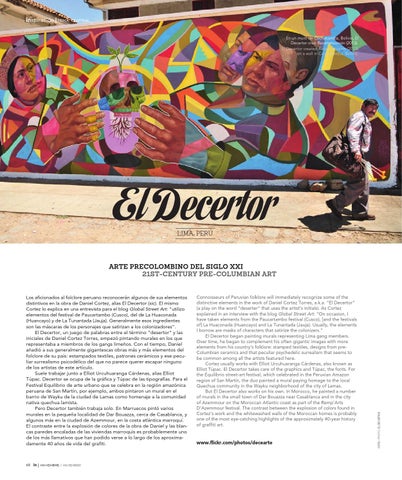inspiración | TEMA CENTRAL_ COVER STORY En un muro de Cochabamba, Bolivia, El Decertor creó Reconstrucción (2013). El Decertor created Reconstrucción (2013) on a wall in Cochabamba, Bolivia.
El Decertor LIMA, PERÚ
Los aficionados al folclore peruano reconocerán algunos de sus elementos distintivos en la obra de Daniel Cortez, alias El Decertor (sic). El mismo Cortez lo explica en una entrevista para el blog Global Street Art: “utilizo elementos del festival de Paucartambo (Cusco), del de La Huaconada (Huancayo) y de La Tunantada (Jauja). Generalmente esos ingredientes son las máscaras de los personajes que satirizan a los colonizadores”. El Decertor, un juego de palabras entre el término ”desertor” y las iniciales de Daniel Cortez Torres, empezó pintando murales en los que representaba a miembros de los gangs limeños. Con el tiempo, Daniel añadió a sus generalmente gigantescas obras más y más elementos del folclore de su país: estampados textiles, patrones cerámicos y ese peculiar surrealismo psicodélico del que no parece querer escapar ninguno de los artistas de este artículo. Suele trabajar junto a Elliot Urcuhuaranga Cárdenas, alias Elliot Túpac. Decertor se ocupa de la gráfica y Túpac de las tipografías. Para el Festival Equilibrio de arte urbano que se celebra en la región amazónica peruana de San Martín, por ejemplo, ambos pintaron un mural en el barrio de Wayku de la ciudad de Lamas como homenaje a la comunidad nativa quechua lamista. Pero Decertor también trabaja solo. En Marruecos pintó varios murales en la pequeña localidad de Dar Bouazza, cerca de Casablanca, y algunos más en la ciudad de Azemmour, en la costa atlántica marroquí. El contraste entre la explosión de colores de la obra de Daniel y las blancas paredes encaladas de las viviendas marroquís es probablemente uno de los más llamativos que han podido verse a lo largo de los aproximadamente 40 años de vida del grafiti.
Connoisseurs of Peruvian folklore will immediately recognize some of the distinctive elements in the work of Daniel Cortez Torres, a.k.a. “El Decertor” (a play on the word “deserter” that uses the artist’s initials). As Cortez explained in an interview with the blog Global Street Art: “On occasion, I have taken elements from the Paucartambo festival (Cusco), [and the festivals of] La Huaconada (Huancayo) and La Tunantada (Jauja). Usually, the elements I borrow are masks of characters that satirize the colonizers.” El Decertor began painting murals representing Lima gang members. Over time, he began to complement his often gigantic images with more elements from his country’s folklore: stamped textiles, designs from preColumbian ceramics and that peculiar psychedelic surrealism that seems to be common among all the artists featured here. Cortez usually works with Elliot Urcuhuaranga Cárdenas, also known as Elliot Túpac. El Decertor takes care of the graphics and Túpac, the fonts. For the Equilibrio street-art festival, which celebrated in the Peruvian Amazon region of San Martín, the duo painted a mural paying homage to the local Quechua community in the Wayku neighborhood of the city of Lamas. But El Decertor also works on his own. In Morocco, he painted a number of murals in the small town of Dar Bouazza near Casablanca and in the city of Azemmour on the Moroccan Atlantic coast as part of the Remp’Arts D’Azemmour festival. The contrast between the explosion of colors found in Cortez’s work and the whitewashed walls of the Moroccan homes is probably one of the most eye-catching highlights of the approximately 40-year history of graffiti art.
www.flickr.com/photos/decearte
FOTO / PHOTO: EL DECERTOR
Arte precolombino del siglo XXi 21st-century pre-columbiAn Art
68 in | NOViEMbRE / NOVEMbER
IN_115_COVER 03.indd 68
16-10-13 10:17
